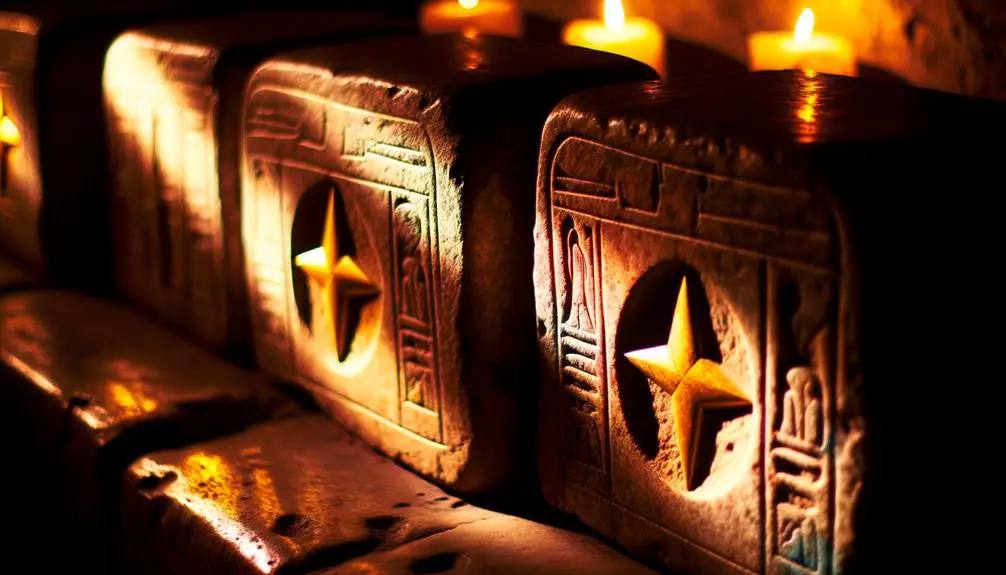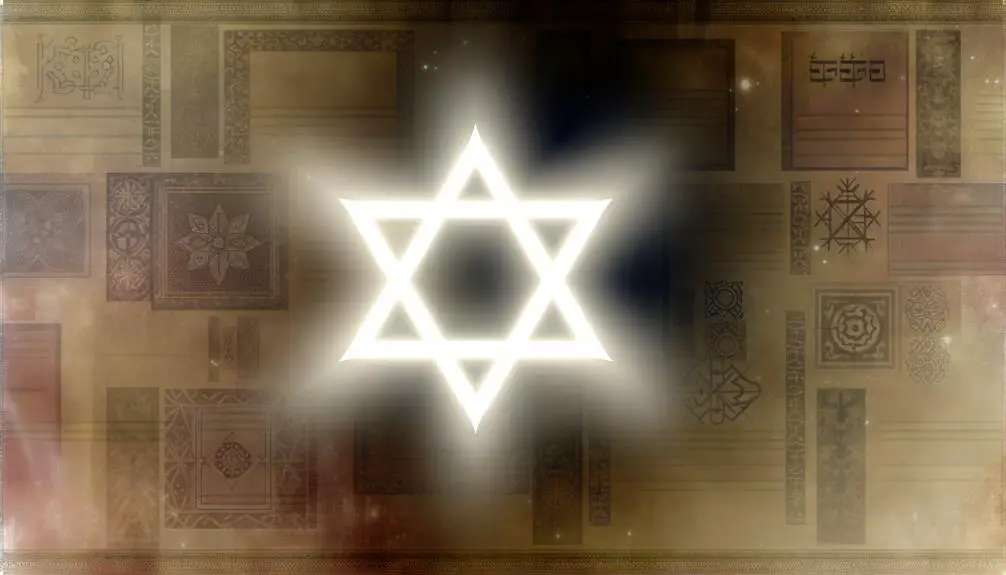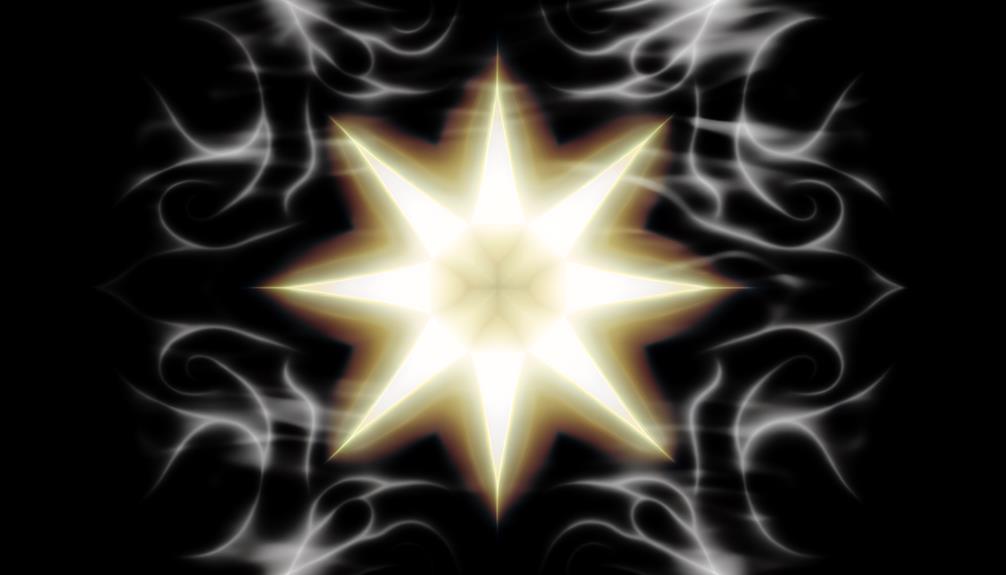How to Decode the 5 Point Star Symbol Meaning: Step-by-Step Guide
The 5-point star, revered in ancient civilizations, embodies celestial deities, divine guidance, and the cosmos' mysteries. In religious contexts, it symbolizes enlightenment and higher powers, evident in Christianity's Star of Bethlehem and Islam's star and crescent.
Historically, it represents natural elements and life's cycles, revered as a protective emblem against evil, notably linked to Mesopotamian goddess Ishtar. Modernly, it signifies aspiration, creativity, and excellence, widely used in art, corporate logos, and popular culture.
This symbol's enduring resonance reflects its rich, multifaceted heritage, promising deeper insights into its evolving significance.

Key Takeaways
- The five-point star is often associated with protection and safety, historically linked to the goddess Ishtar and medieval European pentagrams.
- In many cultures, the five-point star represents celestial guidance and divine presence, such as the Star of Bethlehem in Christianity.
- The star symbolizes aspiration and achievement, widely used in modern art, design, and corporate logos to evoke excellence.
- Stars embody natural elements and cosmic energy, connecting to earth, air, fire, water, and the cyclical rhythms of life in ancient traditions.
- The five-point star signifies harmonious balance in Chinese tradition, representing the five essential elements in nature.
Ancient Civilizations

Throughout ancient civilizations, star symbols held profound significance, often representing celestial deities, divine guidance, and the cosmos' mysteries.
In Mesopotamia, the star was central to their astronomical and astrological practices, symbolizing divine authority and cosmic order.
The Egyptians associated stars with the afterlife, believing them to be the souls of the deceased.
In Greek culture, stars were integral to mythology, as seen in the constellations named after gods and heroes.
The Aztecs and Mayans used star patterns for calendrical and agricultural purposes, highlighting their sophisticated understanding of astronomy.
These diverse interpretations underscore the star's universal role as a bridge between human experience and the enigmatic universe, reflecting a shared quest to comprehend the celestial domain.
Religious Significance

The star symbol has long held profound religious significance, often serving as a divine emblem across various faith traditions to represent guidance, enlightenment, and the presence of higher powers. In Christianity, the Star of Bethlehem guides the Wise Men to the birthplace of Jesus. In Islam, the star and crescent symbolize faith and divine direction. Hinduism reveres stars as manifestations of celestial beings. Judaism's Star of David symbolizes divine protection and unity.
| Religion | Star Symbol Meaning |
|---|---|
| Christianity | Guidance and the birth of Jesus |
| Islam | Faith and divine direction |
| Hinduism | Manifestations of celestial beings |
| Judaism | Divine protection and unity |
These interpretations underscore the star's role as a beacon of spiritual illumination and divine presence across cultures.
Elements of Nature

Stars have historically symbolized the fundamental elements of nature, embodying cosmic energy, natural cycles, and the vastness of the universe.
In various ancient cultures, star symbols were intricately linked to the four classical elements: earth, air, fire, and water. For instance, the five-pointed star, or pentagram, was often used to represent these elements, with each point corresponding to one element and the fifth symbolizing the spirit or ether. This association underscores humanity's recognition of interconnectedness within the natural world.
Stars were perceived as guiding lights in the night sky, influencing agricultural practices and navigation. Their cyclical patterns mirrored the rhythms of life, making them enduring emblems of natural order and harmony across civilizations.
Protective Emblem

Across various cultures and epochs, the star symbol has been revered as a powerful protective emblem, believed to ward off evil and bring safety to those who bear it.
In ancient Mesopotamia, the star was linked to the goddess Ishtar, symbolizing divine protection and guidance.
Similarly, the Pentagram, with its five points, was used in medieval Europe by magicians and alchemists as a protective charm against malevolent forces.
In Chinese tradition, the star represents the harmonious balance of the five elements, forming a cosmic shield.
Even in modern times, the star remains a universal icon of protection, often seen in talismans and amulets, reflecting a deep-rooted belief in its ability to secure and safeguard.
Modern Interpretations

While the star has historically served as a potent symbol of protection, its modern interpretations have evolved to encompass a broader range of meanings and applications in contemporary culture. Today, the star is often seen as a representation of aspiration, inspiration, and achievement. It frequently appears in diverse contexts, such as:
- Art and Design: Artists and designers utilize star motifs to evoke a sense of wonder and creativity.
- Corporate Logos: Companies employ stars to symbolize excellence and innovation.
- Popular Culture: Stars are ubiquitous in media, representing fame, guidance, and celestial beauty.
Understanding these modern applications offers a nuanced view of how historical symbols can adapt and thrive in evolving cultural landscapes, reflecting both continuity and change.
Conclusion
The five-point star symbol, with its origins in ancient civilizations and religious contexts, embodies multifaceted meanings ranging from natural elements to protective emblems. Its historical evolution demonstrates a profound cultural resonance, while modern interpretations continue to explore its rich symbolism.
Investigating the theory that the star's enduring significance lies in its universal appeal reveals a complex interplay of historical, religious, and cultural factors. This nuanced interpretation underscores the star's timeless and multifarious nature.






